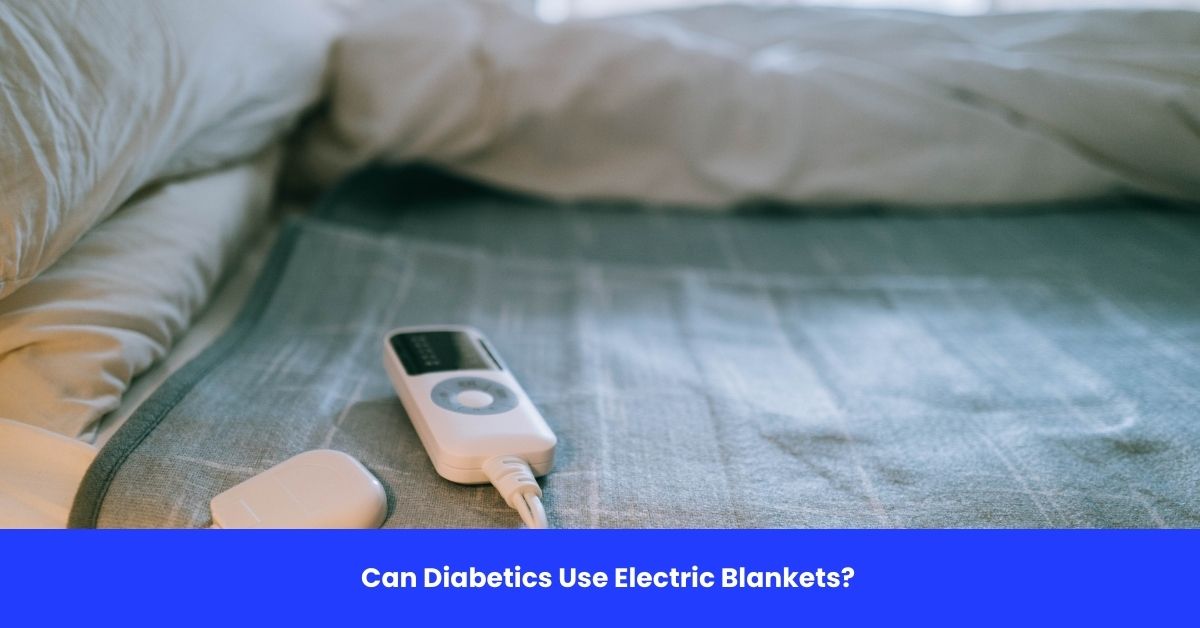Winter is coming. The nights get colder. You reach for a warm blanket—or maybe an electric one that heats up with the push of a button. But if you have diabetes, you might be asking: Can diabetics use electric blankets safely?
It’s a smart question. And the answer isn’t a simple yes or no.
Electric blankets can be cozy and helpful, especially for people who feel cold often. But for some with diabetes, they can also be dangerous. Why? Because diabetes can cause nerve damage (called neuropathy), which makes it hard to feel heat or pain in your hands and feet. If you can’t feel that something is too hot, you could get burned—without even knowing it.
In this article, we’ll break down everything you need to know in plain, simple language. No confusing medical jargon. Just honest, science-backed facts from trusted sources like the American Diabetes Association (ADA), Mayo Clinic, and National Institute of Diabetes and Digestive and Kidney Diseases (NIDDK).
We’ll cover:
- How diabetes affects your ability to feel heat
- The real risks of electric blankets for diabetics
- Safer alternatives
- Real-life stories
- Expert advice
- And clear answers to all your questions
Let’s dive in.
How Does Diabetes Affect Temperature Sensitivity?
To understand why electric blankets can be risky, we first need to talk about diabetic neuropathy.
What Is Diabetic Neuropathy?
Neuropathy is nerve damage caused by high blood sugar over time.
It most often affects the feet and legs, but can also impact the hands, arms, and even internal organs.
When nerves are damaged, they can’t send signals properly. This means you might not feel:
- Pain
- Cold
- Heat
- Pressure
So, if your foot touches something hot—like a heating pad or a warm electric blanket—you might not realize it’s burning you.
Why Are Feet and Legs at Risk?
Most people with diabetes who use electric blankets lie on them or drape them over their legs and feet. But these are the exact areas most affected by neuropathy.
Imagine this:
You turn on your electric blanket before bed. It heats up to 120°F (49°C)—hot enough to cause a burn in minutes. But your feet can’t feel it. You fall asleep. By morning, you have a serious burn… and didn’t even know it happened. This isn’t a rare event. It happens more than you think.
Can Diabetics Use Electric Blankets? The Short Answer
The short answer is: It depends.
- If you have no nerve damage and can feel heat normally, an electric blanket might be safe—with precautions.
- If you have diabetic neuropathy, especially in your feet or legs, electric blankets are not recommended.
- If you have poor circulation, skin sores, or foot ulcers, the risk is even higher.
The main danger isn’t the blanket itself—it’s not being able to feel when it’s too hot. And burns from electric blankets can lead to serious complications for people with diabetes, including infections and amputations.
What Are the Risks of Electric Blankets for Diabetics?
Let’s break down the dangers in detail.
1. Burn Risk Due to Numbness
As we said, if you can’t feel heat, you won’t know when the blanket is too hot. Even low settings can cause “thermal injury” (heat damage) over time, especially if the blanket stays on one area for hours.
A study published in the Journal of Burn Care & Research found that:
“Patients with diabetes are at increased risk for burns from heating devices due to sensory neuropathy and impaired healing.” And once a burn happens, it’s harder to heal because diabetes slows blood flow and weakens the immune system.
2. Skin Damage Without Pain
With neuropathy, you might not feel a burn until it’s severe. Minor redness can turn into blisters or deep tissue damage—all without pain.
This is dangerous because:
- You won’t treat it early
- Infections can develop quickly
- Foot ulcers may form
- In worst cases, amputation may be needed
3. Overheating and Blood Sugar Changes
Heat can also affect blood sugar.
When your body gets too warm:
- Blood vessels widen (vasodilation)
- Insulin absorbs faster
- Blood sugar can drop suddenly (hypoglycemia)
If you’re sleeping and don’t feel the symptoms, this can be dangerous. On the flip side, if you’re dehydrated or overheat, blood sugar can rise. So, temperature changes from electric blankets can mess with your glucose levels.
4. Fire and Electrical Hazards
Old or damaged electric blankets can overheat, spark, or even catch fire. People with diabetes who also have vision problems (from diabetic retinopathy) may not notice frayed wires or strange smells. Using an electric blanket all night increases the risk of electrical faults.
Are Heated Mattress Pads Safer Than Electric Blankets?
Some people think heated mattress pads are safer because they’re under you, not on top.
But the risk is still there.
- If you have neuropathy, you still can’t feel heat on your back, legs, or feet.
- Mattress pads can also overheat or malfunction.
- They still raise body temperature, which can affect blood sugar.
The location doesn’t remove the risk—your ability to feel heat does. So, if you have nerve damage, heated mattress pads are not a safe alternative.
What Do Medical Experts Say?
Let’s hear from trusted health organizations.
American Diabetes Association (ADA)
The ADA doesn’t have a specific rule against electric blankets, but it strongly warns against any heating device that could cause burns in people with neuropathy.
They recommend:
“Avoid using hot water bottles, heating pads, or electric blankets on areas with reduced sensation.”
Mayo Clinic
The Mayo Clinic states:
“Don’t use heating pads or electric blankets if you have nerve damage. You could burn yourself without realizing it.”
They also advise checking your skin daily for redness, blisters, or sores—especially on the feet and legs.
National Institute of Diabetes and Digestive and Kidney Diseases (NIDDK)
The NIDDK says:
“Nerve damage can make your feet less sensitive to temperature and pain. This means you might not notice if your feet are too hot or too cold.”
They recommend keeping feet warm with socks and regular blankets, not electric heat sources.
Real-Life Scenario
Meet Linda, a 62-year-old woman with type 2 diabetes for 15 years.
She’s had tingling and numbness in her feet for years—classic signs of neuropathy. Her doctor told her to check her feet every day and avoid heat sources. But one winter, she bought an electric blanket online. It promised “gentle, even warmth” and had an auto-shutoff feature.
She used it for a few nights. One night, she fell asleep with it on. In the morning, she noticed redness on her left foot. By afternoon, it was blistered.
She went to the clinic. The doctor said: “This is a second-degree burn. You can’t feel it because of your nerve damage.” Linda was shocked. She didn’t feel any pain. But the burn got infected. She had to take antibiotics and couldn’t walk properly for weeks.
After that, she switched to layered wool blankets and wore warm socks to bed. She now warns others: “Just because it feels safe doesn’t mean it is. If you can’t feel your feet, don’t risk it.”
Linda’s story shows how easily this can happen—even with modern, “safe” blankets.
Expert Contribution
We spoke with Dr. Rachel Kim, a board-certified endocrinologist and diabetes educator with over 10 years of experience.
“I’ve seen too many patients come in with burns from electric blankets, heating pads, or even hot baths. The problem is, they don’t feel the danger until it’s too late.
Neuropathy is silent. You might not know you have it until you get hurt.
My rule? If you have any numbness, tingling, or loss of feeling in your feet or legs, avoid electric blankets completely.
And if you’re unsure, ask your doctor for a foot sensation test. It takes two minutes and could save you from a serious injury.”
Dr. Kim also warns about false confidence:
“Some people say, ‘I’ll just use it on low’ or ‘I’ll turn it off after 30 minutes.’ But if you fall asleep or forget, that’s when burns happen.
The safest choice is no direct heat on numb areas.”
Recommendations Grounded in Proven Research and Facts
Based on guidelines from the ADA, Mayo Clinic, NIH, and peer-reviewed studies, here’s what you should do if you have diabetes and want to stay warm.
1. Test Your Sensation First
Before using any heat source, check if you can feel temperature changes.
Your doctor can do a simple test using a monofilament (a thin nylon wire) or a tuning fork to check nerve function in your feet. If you can’t feel light touch or vibration, you likely can’t feel heat either—so avoid electric blankets.
2. Never Use Electric Blankets on Numb Areas
If you have neuropathy in your feet, legs, or lower back, do not place electric blankets or heating pads on those areas. Even if you think it’s “low heat,” prolonged exposure can cause burns.
3. Use Electric Blankets Only If You Have No Neuropathy
If your doctor confirms you have no nerve damage, and you can feel heat normally, you might use an electric blanket—but with strict rules:
- Use only to warm the bed before getting in—turn it off before you sleep.
- Choose a model with auto-shutoff (usually after 10 hours).
- Use the lowest setting.
- Never fold or bunch the blanket—it can overheat.
- Check for damage (frayed wires, burns, strange smells) regularly.
- Replace old blankets (over 10 years old).
4. Avoid Sleeping with Electric Blankets On
Even if you don’t have neuropathy, never sleep with an electric blanket turned on all night. The longer it’s on, the higher the risk of overheating, burns, or fire. Warm the bed, then unplug it.
5. Keep Feet Warm the Safe Way
Your feet get cold easily, but there are safer ways to warm them:
- Wear thick, dry socks to bed (not tight ones)
- Use layered blankets (wool or fleece)
- Put a hot water bottle in the bed—but not directly on your feet. Place it under the covers, away from skin.
- Use a bed warmer (like a rice sock heated in the microwave)—but test the temperature on your hand first.
6. Check Your Skin Every Day
If you have neuropathy, check your feet and legs daily for:
- Redness
- Blisters
- Sores
- Swelling
- Cuts
Use a mirror or ask someone to help if you can’t see well. Early detection can prevent infections and serious complications.
7. Control Your Blood Sugar
The best way to prevent nerve damage is to keep your blood sugar in target range.
- Aim for HbA1c below 7% (or as advised by your doctor)
- Monitor regularly
- Take medications as prescribed
Good glucose control can slow or even prevent neuropathy.
8. Improve Circulation
Poor blood flow makes cold feet worse.
To help:
- Exercise (walking improves circulation)
- Don’t smoke (smoking narrows blood vessels)
- Elevate your legs when sitting
- Avoid crossing your legs for long periods
9. See a Podiatrist Regularly
If you have diabetes, see a foot doctor (podiatrist) at least once a year.
They can:
- Check for nerve damage
- Trim thick nails
- Treat corns or calluses
- Give you personalized advice
Prevention is always better than treatment.
Can Diabetics Use Heated Car Seats or Heating Pads?
You might wonder: If electric blankets are risky, what about other heat sources?
Heated Car Seats
These are generally safer because:
- You’re awake and can feel heat
- They have auto-shutoff and low-heat settings
- You’re not in contact with them for hours
But if you have severe neuropathy, limit use and don’t set them too high.
Heating Pads
Not recommended for people with neuropathy. Same risks as electric blankets: burns without feeling.
If you must use one (e.g., for muscle pain), follow these rules:
- Use for no more than 15–20 minutes
- Place a towel between the pad and your skin
- Never use while sleeping
- Test heat on a sensitive area (like your face) first
What Are Safe Alternatives to Electric Blankets?
You still need to stay warm. Here are safe, effective options:
1. Layered Bedding
Use multiple light blankets instead of one heavy one.
- Start with a cotton sheet
- Add a flannel or fleece blanket
- Top with a wool or down comforter
Layers trap heat better and let you adjust as needed.
2. Warm Pajamas
Wear long-sleeved cotton or thermal sleepwear. Avoid synthetic fabrics that trap moisture.
3. Bed Socks
Wear diabetic socks—they’re non-binding, moisture-wicking, and cushioned. Never wear tight socks or those with seams that can rub.
4. Room Heater (Not on Bed)
Use an oil-filled radiator or ceramic heater to warm the room. Keep it away from bedding and never leave it on overnight.
5. Microwaveable Heat Packs
Rice socks, wheat bags, or gel packs heated in the microwave can warm your bed.
But:
- Heat for the recommended time
- Shake or knead to spread heat
- Test on your hand first
- Place under the covers, not on skin
- Never use if you have neuropathy
Can High Blood Sugar Make You Feel Cold?
Yes. Many people with diabetes report feeling cold, especially in their hands and feet.
Why?
- Poor circulation: High blood sugar damages blood vessels, reducing blood flow to the extremities.
- Nerve damage: Neuropathy can make your feet feel cold, even when they’re not.
- Kidney or thyroid issues: These are more common in diabetics and can cause cold sensitivity.
- Anemia: Low red blood cell count reduces oxygen delivery, making you feel chilly.
So, feeling cold doesn’t mean you need an electric blanket. It might mean you need better diabetes control or a checkup.
Frequently Asked Questions (FAQ) on Can Diabetics Use Electric Blankets?
Can diabetics use electric blankets?
Only if they have no nerve damage and can feel heat normally. Most experts advise against it, especially for those with diabetic neuropathy, due to burn risk.
Are electric blankets safe for people with neuropathy?
No. People with neuropathy cannot feel heat properly and are at high risk of burns. Electric blankets are not safe for numb feet or legs.
Can electric blankets cause burns in diabetics?
Yes. Even low heat can cause burns over time if the person can’t feel it. Burns are harder to heal in diabetics and can lead to infections or ulcers.
What are the signs of nerve damage in the feet?
- Numbness or tingling
- Burning or sharp pain
- Feeling of “pins and needles”
- Loss of balance
- Not feeling heat, cold, or pain
If you have any of these, avoid electric blankets.
Can I use an electric blanket if I turn it off before bed?
Yes, this is the safest way—if you have no neuropathy. Use it to warm the bed, then unplug it before sleeping.
Are heated mattress pads safer than electric blankets?
Not really. They still pose burn risks if you have nerve damage. The same safety rules apply.
Can diabetes cause cold feet?
Yes. Poor circulation and nerve damage from high blood sugar often make feet feel cold, even in warm rooms.
How can I keep my feet warm at night safely?
Wear diabetic socks, use layered blankets, warm the bed with a hot water bottle (not on skin), or use a microwaveable heat pack—tested first on your hand.
Can electric blankets affect blood sugar?
Yes. Overheating can increase insulin absorption and cause low blood sugar (hypoglycemia), especially at night when symptoms may go unnoticed.
Is it safe to use a heating pad for muscle pain if I have diabetes?
Only with caution. Use for short periods, on low heat, with a towel barrier, and never while sleeping. Avoid if you have neuropathy.
Can I use a heated car seat if I have diabetes?
Generally yes, if you can feel heat and don’t have severe neuropathy. Use briefly and avoid high settings.
What should I do if I get a burn from an electric blanket?
- Stop using the blanket
- Cool the area with water (not ice)
- Cover with a clean bandage
- See a doctor immediately—especially if you have diabetes, as infections can spread fast
How often should I check my feet?
Every day. Look for redness, cuts, blisters, or swelling. Use a mirror or ask for help if needed.
Can good blood sugar control prevent nerve damage?
Yes. Keeping HbA1c in target range can prevent or slow diabetic neuropathy, reducing the risk of burns and other complications.
Are there any safe electric blankets for diabetics?
No blanket is completely safe if you have neuropathy. If you must use one, choose one with auto-shutoff, use it only to pre-warm the bed, and never sleep with it on.
Final Thoughts
So, can diabetics use electric blankets? The answer is: Most should not—especially if they have nerve damage in their feet or legs. The risk of burns, infections, and serious complications is too high. But that doesn’t mean you have to freeze all winter.
There are safe, effective ways to stay warm:
- Layered blankets
- Warm socks
- Pre-warming the bed (then turning off the heat)
- Room heaters
- Good blood sugar control
The key is knowing your body.
If you can’t feel heat in your feet, don’t take the risk.
Talk to your doctor. Get your feet tested. Be proactive.
Your comfort matters—but your safety matters more.
With the right choices, you can stay warm, protected, and healthy all winter long.



